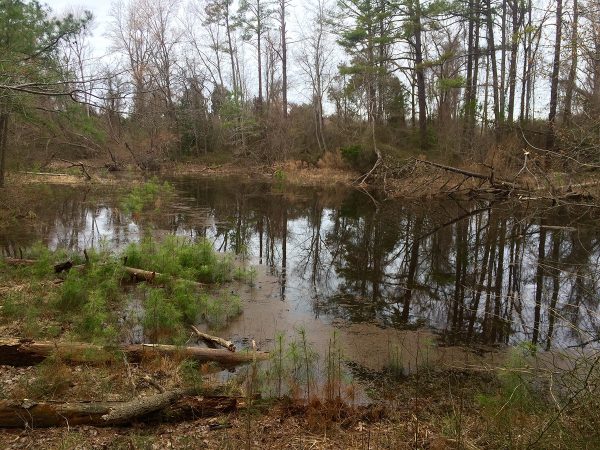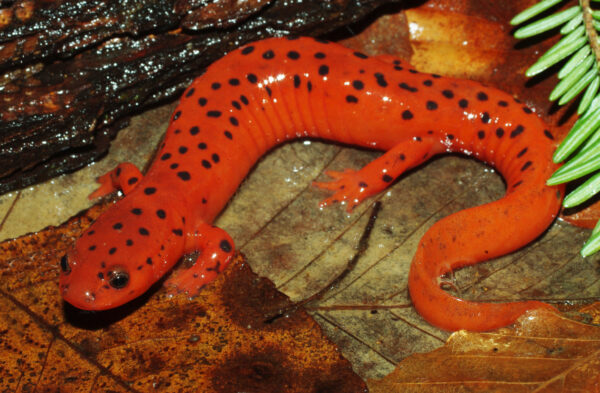
Photo by Devin Floyd, Center for Urban Habitats.
Spring is imminent and the first rains have arrived—and so have the salamanders! With warming temperatures and all the snow melting over the past few weeks, some salamander species have been on the move looking for vernal pools. A vernal pool is a seasonal, “ephemeral” or temporary type of wetland habitat that’s formed by the accumulation of winter rains and snowfall, typically in shallow depressions in woodlands.
Virginia is home to 50 salamander species. The majority of these are nocturnal and carnivorous, preying on insects and also frogs, fish, and even other salamanders. Some of the species are fully aquatic, while others are semi-aquatic or fully terrestrial. The ones we see migrating in spring are semi-aquatic. Throughout most of the year, semi-aquatic species like spotted salamanders and eastern tiger salamanders live on land beneath rocks and logs, or in the cool, moist leaf litter of deciduous or mixed forests. Over the winter they hibernate underground, and then from late winter through early spring—peaking in March and April—hundreds of them emerge to find water, seek a mate and breed, en masse.
There’s a lot of excitement in the air when salamander enthusiasts don headlamps on a nighttime adventure in the rain, looking for these long-tailed amphibians scurrying across roads, where the critters are easiest to find. Recently an unusual emergence of spotted salamanders occurred in Albemarle County, and we thank Devin Floyd of Center for Urban Habitats for sharing his photos of these incredible animals—more than seven inches long! —crossing Rte. 29 in the Charlottesville area.
Female spotted salamanders will lay hundreds of eggs a few days after mating, and within a few weeks of development, the young salamander larvae will wriggle free and disperse, to begin solitary lives back in the woods.

Midland Mud Salamander. © Mike Graziano
At my own home, I marvel at salamander eggs which appear every spring in a small water garden in my backyard. The gelatinous blobs are attached to plant stems just below the water’s surface, and there are dozens of larvae in each egg mass. Some salamander species lay egg masses containing hundreds of larvae.
Salamanders, like other amphibians, have moist, permeable skin, which makes them vulnerable to chemical pollutants and other contaminants in storm water runoff. Because these animals are very sensitive to changes in water quality, they are important indicators of environmental health. If a stream runs through your neighborhood, you can help salamanders and other aquatic wildlife by minimizing or discontinuing the use of fertilizers and herbicides on your lawn, and by allowing at least a 20-foot-wide buffer of native plants to grow along the edges of the stream. If there’s a low-lying, wet spot in your yard, avoid mowing it, and instead allow water-loving plant species to grow there, which will help retain the moisture and provide much-needed cover.
You can also improve amphibian habitat around your home by installing a small in-ground water garden that will function like a vernal pool, as long as you don’t add any fish. Also, allow leaves that fall in autumn to remain on the ground as protective cover throughout the year, rather than bagging them up and removing them off site.
For maximum benefit to wildlife, consider creating a vernal pool or constructing a small wetland on your property. See the example at Boxley’s Piney River Quarry in Amherst County.
Here are more resources for learning about salamanders and the habitats that support them:
- Virginia’s Vernal Pools
- Guide to Creating Vernal Ponds (PDF)
- Salamander Biodiversity and Conservation (PDF)
- Springtime Brings Vernal Pools and Salamanders
- Salamander News (PDF)
- For teachers and their students—a fun video about Salamander Habitat (#SmokiesCool) by Maplewood Richmond Heights Middle School in the Great Smokey Mountains TN (In Virginia, the counterpart to the habitat of the Great Smokeys are the Appalachian mountains.)
— Carol A. Heiser, Habitat Education Coordinator


